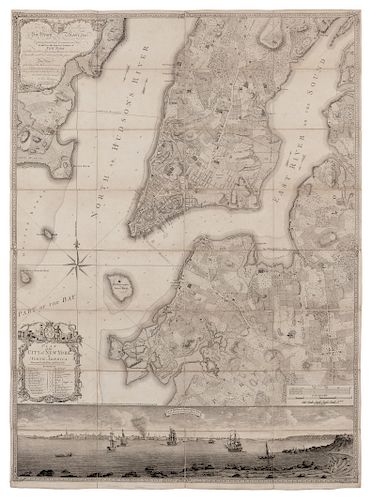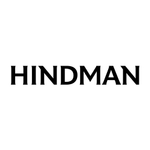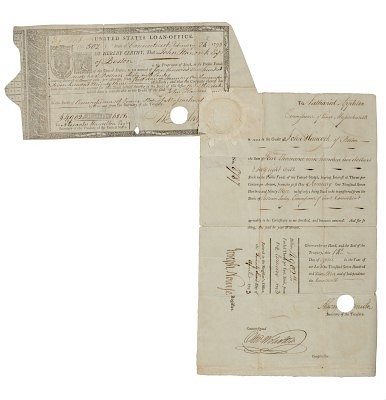RATZER, Bernard (fl. 1756-1777). Plan of the City of New York in North America, surveyed in the years 1766 & 1767. London: Jefferys and Faden, "Jan.y"
Lot 381
About Seller
Hindman
1338 West Lake Street
Chicago, IL 60607
United States
Recognized as the Midwest's leading fine art auctioneers, Hindman Auctioneers has built a worldwide reputation based on a full service approach to the auction business tailored to meet the individual needs of our clients. Coming from a variety of educational backgrounds, specialists bring years of e...Read more
Categories
Estimate:
$80,000 - $120,000
Absentee vs Live bid
Two ways to bid:
- Leave a max absentee bid and the platform will bid on your behalf up to your maximum bid during the live auction.
- Bid live during the auction and your bids will be submitted real-time to the auctioneer.
Bid Increments
| Price | Bid Increment |
|---|---|
| $0 | $25 |
| $500 | $50 |
| $1,000 | $100 |
| $2,000 | $250 |
| $5,000 | $500 |
| $10,000 | $1,000 |
| $20,000 | $2,500 |
| $50,000 | $5,000 |
| $100,000 | $10,000 |
About Auction
By Hindman
Nov 6, 2019
Set Reminder
2019-11-06 11:00:00
2019-11-06 11:00:00
America/New_York
Bidsquare
Bidsquare : Fine Books and Manuscripts including Americana
https://www.bidsquare.com/auctions/hindman-auctions/fine-books-and-manuscripts-including-americana-4507
Hindman Bidsquare@hindmanauctions.com
Hindman Bidsquare@hindmanauctions.com
- Lot Description
RATZER, Bernard (fl. 1756-1777). Plan of the City of New York in North America, surveyed in the years 1766 & 1767. London: Jefferys and Faden, “Jan.y” 12, 1776.
Copper-engraved plan of New York on four sheets, joined. Overall sheet 48 ½ x 35 ½ in (1235 x 900 mm), deckle edges. With engraved panoramic view of New York below map after a painting by Robert Davies at bottom. (Dissected into 16 sections, with later linen backing; some minor curling at seam edges). Float-mounted and framed. "PERHAPS THE FINEST MAP OF AN AMERICAN CITY and its environs produced in the eighteenth century" (Augustyn). Second issue (after the ca 1770 issue known in three copies). The Ratzer map is a cartographic masterpiece, the finest map of any American city produced in the 18th century, and is one of the most important iconographic symbols of the city of New York. Its artistic virtuosity and unrivaled accuracy define it as the apogee of a sequence of great maps of the city produced just before and during the Revolutionary War with a sharpness and sensitivity of draftsmanship that makes it stand alone from any other American maps of this period. Ratzer's map developed from surveys of 1766 and 1767, the first engraved form was his "Ratzen" plan of the city itself published in 1769, engraved by Kitchen. By ca 1770 the larger plan of the city and its environs had been finished and was published undated by Thomas Kitchin. The elaborate survey showing the southern end of Manhattan island, (as far north as 50th Street today), the marshy New Jersey shores of the Hudson, Kennedy, Bucking and Governors Islands, and parts of present-day Brooklyn along the East River. Title set on lower left corner of map with decorative cartouche and list of references, one compass rose, inset scale bar, and dedication to Sir Henry Moore, Governor of New York. The map surmounting an engraved panoramic view of the city from Governors island, after a 1760 view by Captain Davies. The Ratzer map was first published in London by Thomas Kitchin ca 1770, but only two copies of this first issue survive today. The present copy, the second issue, was published by Jefferys and Faden, and although they were commercial publishers, it was rarely included in Faden's North American Atlas of 1777. Bernard Ratzer served in the British Army in the 60th or American regiment. His earliest known map is a manuscript chart of Passamquoddy Bay in Maine in 1756. Various other manuscript plans of forts followed, and he collaborated with Sauthier on his survey of New York, published in 1776. In 1769 Sir Henry Moore gave him the task of surveying the New York New Jersey border. Despite the commercial nature of Faden and Jefferys, this New York plan had a limited circulation and certainly very few copies are seen on the market today. It ranks as one of the most attractive of all maps, one of the high points of the art of the military map maker. Cohen & Augustyn, Manhattan in Maps, pp.73-77; Schwartz & Ehrenberg, The Mapping of America, p. 192; Stokes, Iconography ("one of the most beautiful, important and accurate plans of New York."), p. 341.
For condition inquiries please contact Gretchen Hause at gretchenhause@hindmanauctions.comCondition
- Shipping Info
-
Please refer to https://hindmanauctions.com/shipping-packing
-
- Buyer's Premium



 EUR
EUR CAD
CAD AUD
AUD GBP
GBP MXN
MXN HKD
HKD CNY
CNY MYR
MYR SEK
SEK SGD
SGD CHF
CHF THB
THB











